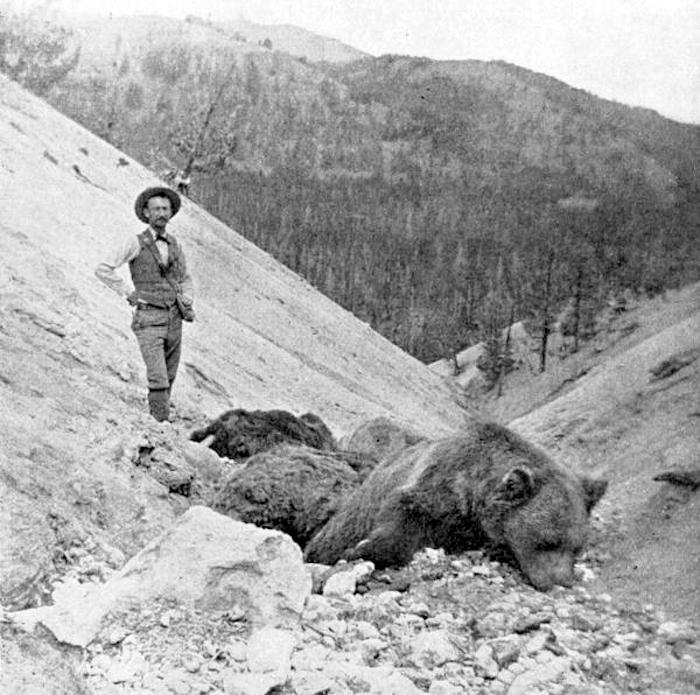
The carcass of a large silver-tipped grizzly bear, which succumbed to poisonous gases in the area known as "Death Gulch" in Yellowstone National Park in 1897/Public Domain
Editor's note: Yellowstone Caldera Chronicles is a weekly column written by scientists and collaborators of the Yellowstone Volcano Observatory. This week's contribution is from Jennifer Lewicki, research geologist with the U.S. Geological Survey in Menlo Park, CA.
Are gas emissions at Yellowstone dangerous? You may ask this question while walking along the boardwalks of Yellowstone's geyser basins, where you'll see billowing white gas plumes or wrinkle your nose at a stinky "rotten egg" smell. In fact, it's a question that has been considered by scientists and visitors to the area for over a century.
In 1897, geologist Thomas Jaggar (who would later go on to found the Hawaii Volcano Observatory) led a field party to visit "Death Gulch", a small, steep ravine in a remote hot springs area in what is now Yellowstone National Park. Here, the deaths of numerous bears, elk, rodents and insects had been reported. The group came across eight new bear carcasses during their visit to Death Gulch, and Jaggar surmised that their deaths had been caused by exposure to poisonous levels of carbon dioxide (CO2) and hydrogen sulfide (H2S) gases.
Over a hundred years later, in 2004, five dead bison were discovered in Yellowstone's Norris Geyser Basin. Strangely, the bison lacked markings on their bodies that would suggest they were attacked by predators. Based on the position of their bodies, it appeared that the animals had died suddenly and as a group. Similar to the events at Death Gulch, park scientists concluded that their deaths were likely caused by buildup of lethal levels of carbon dioxide and hydrogen sulfide gases at the ground level, where the animals were grazing.
The gases emitted from Yellowstone's hydrothermal areas are composed mostly of water vapor, a harmless gas. However, other gases that are poisonous to people and animals when present in certain concentrations are also found within these emissions. Carbon dioxide is a colorless and odorless gas, while hydrogen sulfide is colorless, flammable and has the distinctive rotten-egg smell that many people notice in the geyser basins. Both gases are heavier than air. In most circumstances, wind will dilute carbon dioxide and hydrogen sulfide to low concentrations that do not threaten the health of people and animals. In certain very stable atmospheric conditions, though, these relatively heavy gases can accumulate in low-lying areas and pose a serious hazard. This was likely the case in 2004, when the dead bison were found in Norris Geyser Basin after an unusually cold and still night. These specific circumstances likely allowed gases to build up near the ground surface to concentrations that were lethal to the grazing animals.
Under most weather conditions, visitors will not be bothered by the gas emissions that are an integral part of Yellowstone's fascinating hydrothermal areas. However, as recommended by the National Park Service, people should remain aware of potential gas hazards when exploring these areas and leave immediately if feeling sick. Even though there is no record of any human deaths due to exposure to gases at Yellowstone, the lessons of Death Gulch and the Norris bison provide warnings that should be heeded.



Comments
So what happened to the man standing by the dead bear?
The man standing by the dead bear was my great grandfather Harold Stiglitz. Shortly after this photo was taken, he impregnated Thelma Hoskins, whom he married about two months after wards. By and by they had 11 more children. Family lore says that Harry always considered that trip to the Yellowstone country as the acme of his life.
so why is it ok at Yellowstone but Hawaii Volcano NP closes down cerrain areas for gases? Of course, I'm talking before the current eruption.
apparently if the gases don't kill you, they make you very fertil.
LOL
Those tourists that insist on breaking the law by interacting with the wildlife - think selfies - should be herded to these locations
I like that idea. I say that as someone who travels "through" Yellowstone three to four times a year from ID to Cody.
Why are we allowed to roam free in Yellowstone if the gases are so dangerous. There are no signs posted to the hazards. Now I'm worried so that we may stay away from there. It's been our yearly thing to do for over 25 years.